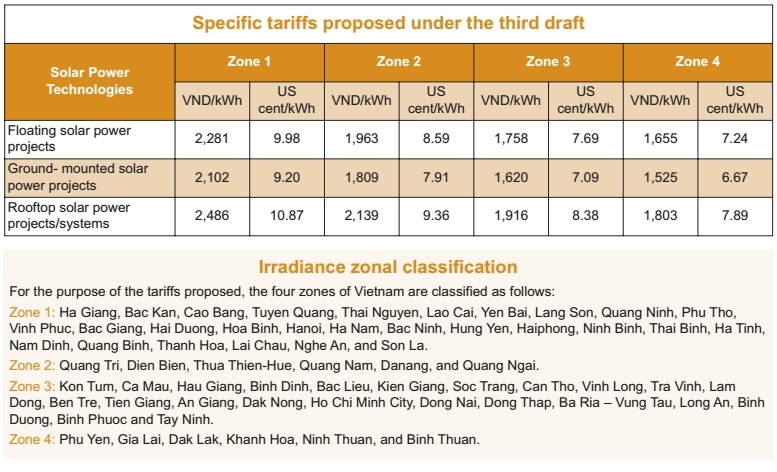Making headway with draft solar power rules
 |
The draft decision provides for a second feed-in tariff (FiT) programme between July 1, 2019 and December 31, 2021, with rates varying by location. Compared to the second draft, released in February, the latest version has made certain improvements for investors. The first is an extension of the programme by six months, after initial end date was scheduled for June 30, 2021 under the second draft. The second addition is an increase in FiT rates for floating solar power projects by about 5.7 per cent.
Third, there is incorporation of a special policy for the central province of Ninh Thuan in allowing certain solar projects with a total combined capacity cap of 2,000 megawatts and achieving commercial operation date by the end of 2020 to be eligible for the extended FiT of 9.35 US cents per kilowatt hour. However, the third draft has removed solar power projects with an integrated storage system from the draft Decision together with the previously proposed tariff uder the second edition.
In addition, the third draft remains unchanged regarding the irradiance zonal classification of provinces and cities into four different zones of Vietnam for purposes of the proposed tariff levels, as well as specific tariff rates for ground-mounted solar power projects and rooftop solar power projects and systems.
The draft decision of the second FiT programme is proposed to replace the current Decision No.11/2017/QD-TTg on support mechanisms for the development of solar power projects in Vietnam (as revised by Decision 02) of the prime minister providing for the first programme with one single FiT rate of 9.35 US cents per kWh, in effect only applying to solar power projects achieving commercial operation date before June 30.
Wide-ranging tariffs
Unlike the first format of the FiT, the draft decision proposes varying levels of geographical tariffs according to location and technology, classified by four different irradiance zones and involving a trio of differing solar power technologies. Specifically, it provides for a wide range of tariffs, which vary in the range from 6.67 to 10.87 US cents per kWh.
However, under the third draft, there are still significant differences in tariff rates among different zones, provinces and solar technologies. Specifically, the Ministry of Industry and Trade (MoIT) continues to propose higher tariffs for provinces with lower solar irradiance, primarily the northern provinces of Vietnam. Vice versa, it proposes lower tariffs for locations with higher solar irradiance, namely those provinces in southern and central regions.
This change still illustrates the government’s policy to diversify the locations for solar investments and navigate energy security priorities across different zones of Vietnam. However, this may have a significant impact on many on-going solar power projects already under development or construction in Vietnam (whether they can achieve actual commerical operation date before June 30 or not given that the majority of on-going projects are being developed in southern provinces and the Central Highlands of Vietnam with higher solar irradiance.
Like the second draft, the third separates the six provinces of Ninh Thuan, Binh Thuan, Khanh Hoa, Dak Lak, Gia Lai, and Phu Yen into a new group of irradiance zonal classifications, known as Zone 4. This zone sees the lowest tariff rates, ranging from 6.67 to 7.89 US cents per kWh depending on solar technologies (except for certain projects in Ninh Thuan as mentioned perviously).
In relation to energy storage, in the third draft the MoIT is required to formulate regulations and standards on energy storage. Electricity of Vietnam is also required to research and invest into energy storage solutions for power systems to ensure stable operation when connecting and integrating power from renewable energy resources.
For the purpose of the tariffs proposed, the third draft classifies solar power projects into three areas. The first are floating projects, defined as grid-connected solar power projects with solar PV panels installed on structures floating on the water surface.
The second are ground-mounted solar ventures, defined as grid-connected solar power projects with PV panels installed on the ground, and solar projects with the panels installed on rooftops or civil buidlings with installed capacity of larger than 1MWp.
Lastly are solar power projects with PV panels installed on the roof or attached to a building with installed capacity of 1MWp or less.
 |
| The updated third draft splits solar power ventures in Vietnam into three distinct classifications, Photo: Shutterstock |
 |
Ninh Thuan policy
Following the special policy for Ninh Thuan previously approved under government Resolution No.115/NQ-CP dated August 2018, the draft decision incorporates the same and clarifies the tariff policy for solar power projects in Ninh Thuan.
For the province’s grid-connected solar power projects which were already included in power development plans at all levels have a commerical operation date prior to 2021, and with total capacity not exceeding 2,000MW, the tariff will be VND2,086 per kWh exclusive of VAT. This is equivalent to 9.35 US cents per kWh.
For Ninh Thuan’s solar power projects achieving operations between January 1, 2021 and December 31, 2021, the tariff under the second FiT programme as mentioned above will apply.
It should be noted that the draft decision and Resolution 115 are both still not entirely clear as to which specific solar projects in Ninh Thuan are confirmed to be eligible for the extended FiT of 9.35 US cents per kWh.
The draft decision appears to indicate a first-come, first-served policy based on actual progress of relevant projects, by setting the total capacity cap of 2,000MW. It’s also based on the actual commerical operation deadline before 2021 for relevant solar projects to progress to achieve actual such a date as soon as possible during July 1, 2019 until December 31, 2020 to be eligible for the extended FiT.
By including the note on being already in the power development plans at all levels, it appears that the 2,000MW package is meant to be open for solar power projects in Ninh Thuan regardless of whether they were approved for inclusion at a national level or provincial level of such plans, or whether their installed capacity is above or below 50MWp.
However, it is not entirely clear what point of time is determined for when specific projects are approved for inclusion in the Power Development Plan for purposes of determining eligible projects. Particularly, it is not clear whether eligible projects had to be approved in the plan prior to August 31, 2018 (the effective date of Resolution 115), before July 1, or another later date during the second FiT programme period leading up to December 31, 2020.
What the stars mean:
★ Poor ★ ★ Promising ★★★ Good ★★★★ Very good ★★★★★ Exceptional
Related Contents
Latest News
More News
- Schaeffler reports strong early output from Dong Nai solar project (December 12, 2025 | 15:16)
- Forestry conference highlights biodiversity and sustainability goals (December 09, 2025 | 13:35)
- Home Credit honoured among top 10 sustainable companies in trade and services (December 09, 2025 | 12:18)
- SCG and seven member companies honoured in Top 100 Sustainable Businesses 2025 (December 08, 2025 | 09:00)
- Nestlé Vietnam pioneers sustainable development and promotes business connections (December 06, 2025 | 12:09)
- CSI 2025 highlights rise of Vietnam’s green champions (December 06, 2025 | 09:00)
- Acecook Vietnam named among top 100 sustainable businesses (December 06, 2025 | 08:00)
- Vietnam’s forest carbon credits draw global interest (December 05, 2025 | 17:41)
- Coro Energy to launch BESS Pilot in Vietnam (December 04, 2025 | 15:12)
- Vietnam strengthens energy storage pathway (December 04, 2025 | 15:05)

 Tag:
Tag:






















 Mobile Version
Mobile Version